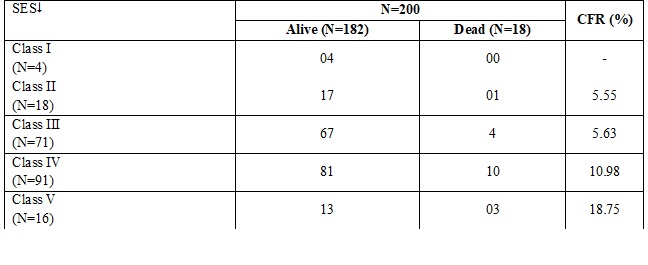Risk Factors of Mortality in Acute Lower Respiratory Tract Infections in Children (1 Month to 5 Years)
Abstract
Introduction: ARI has been estimated to be the single largest cause of death in young children. This study will be used to evaluate factors that may predict mortality due to ALRTI in children, thus helping to identify those at risk, so that timely therapeutic measures may be instituted.
Material and Methods: A prospective case control study on 200 children with acute lower respiratory tract infections in the age group of 1 month to 5 years of age, conducted during the period august 2010 to October 2011 at Ekta institute of child health, Raipur, C.G. Detailed history, clinical examination, radiological and biochemical tests were done. Case fatality rate was calculated using formula- Total number of deaths due to a particular disease / Total number of cases due to the same disease × 100 Chi square test was applied and p value calculated.
Results: Cases were those who died during study & controls were those who were discharged.There were 182 controls and 18 cases, the risk factors which were evaluated are 1-2 months age, male child, class V socioeconomic status, grade IV malnutrition, very severe pneumonia, afebrile, hyponatremic and hypoxemic patients.
Conclusion: In children with an acute lower respiratory tract infection, simple physical signs that require minimal expertise to recognise can be used to determine oxygen therapy and to aid in screening for referral. The association between hypoxemia and death highlights the need for early recognition of the condition and the potential benefit of treatment.
Downloads
References
Gareene M, ponsman C, Campbell H. The magnitude of mortality from acute lower respiratory tract infection in children below 5 years in developing countries. World Health State Q. 1992;45:180-189. https://www.researchgate.net
Kliegman RM, Marcdante KJ, Jenson HJ, et al: Nelson essentials of pediatrics, ed 5, Philadelphia, 2006, Elsevier, p 504, Nelson text book of paediatrics, 19th edition, 2011,chapter392, 5319.
.Govt. of India( 2010),National health profile 2009,DGHS, Ministry of health and family welfare, New Delhi, park text book of preventive and social medicine 21th edition 2011; chapter-5,156-157.
Broor S, Pandey RM Risk factors for severe acute lower respiratory tract infection in under-five children.Indian Pediatr. 2001 Dec;38(12):1361-9.[pubmed]
Victora CG, Smith PG, Barros FC, et al. Risk factors for deaths due to respiratory infections among Brazilian infants. Int J Epidemiol. 1989 Dec;18(4):918-25.
Bokade CM, Madhura AD, Bagul AS, et al. Predictors of mortality in children due to severe and very severe pneumonia. Niger Med J. 2015 Jul-Aug;56(4):287-91. doi: 10.4103/0300-1652.165038.[pubmed]
Champatiray J, SatapathyJ. Clinico-Aetiological Study of Severe and Very Severe Pneumonia in Two Months to Five Years Children in a Tertiary Health Care Centre in Odisha, India.J Clin Diagn Res. 2017 Sep;11(9):SC06-SC10. doi: 10.7860/JCDR/2017/26027.10595. Epub 2017 Sep 1.[pubmed]
Dean P, Florin TA Factors Associated With Pneumonia Severity in Children: A Systematic Review.J Pediatric Infect Dis Soc. 2018 Dec 3;7(4):323-334.[pubmed]
Brown SM, Dean NC. Defining and predicting severe community-acquired pneumonia. CurrOpin Infect Dis. 2010 Apr;23(2):158-64. doi: 10.1097/QCO.0b013e3283368333.[pubmed]
Deivanayagam N, Nedunchelian K, Ramasamy S, et al. Risk factors for fatal pneumonia: a case control study. Indian Pediatr. 1992 Dec;29(12):1529-32.[pubmed]
Lupisan SP, Ruutu P, Predictors of death from severe pneumonia among children 2-59 months old hospitalized in Bohol, Philippines: implications for referral criteria at a first-level health facility.Trop Med Int Health. 2007 Aug;12(8):962-71.[pubmed]
Sehgal V, Sethi GR, Sachdev HP, Predictors of mortality in subjects hospitalized with acute lower respiratory tract infections. Indian Pediatr. 1997 Mar;34(3):213-9.[pubmed]
Weissenbacher M, Carballal G, Avila M et al. Etiology and clinical evaluation of acute lower respiratory tract infection in young Argentinian children : An overview. Rev infect Dis 1990; 12 : S889-90.
Nathoo KJ, Nkrumah FK, Ndlovu D et al. Acute lower respiratory tract infection in hospitalized children in Zimbabwe. Ann Trop pediatr 1993; 13:253-61.
Johnson WB, Aderele WI, Gbadero DA. Host factors and acute lower respiratory infections in pre-school children. J Trop Pediatr. 1992 Jun;38(3):132-6. doi: 10.1093/tropej/38.3.132.[pubmed]
Syed Ibrahim et.al. Study of modifiable risk factors for acute lower respiratory tract infection in under five children, Rajiv Gandhi institute of health sciences.2009
Chisti MJ, Tebruegge M, La Vincente S, et al. Pneumonia in severely malnourished children in developing countries - mortality risk, aetiology and validity of WHO clinical signs: a systematic review. Trop Med Int Health. 2009 Oct;14(10):1173-89. doi: 10.1111/j.1365-3156.2009.02364.x.
Shann F , Barker J, Poore P. Clinical signs that predict death in children with severe pneumonia. Pediatr Infect Dis J 1989;8:852-55.
Spooner V, Barker J, Tulloch S et al. clinical signs & risk factors associated with pneumonia in children admitted to Goraka hospital, Papua New Guinea. J Trop pediatr 1989; 35:295-300.
Tupasi TE, Mangubat NV, Sunico MES et al. Malnutrition and acute respiratory tract infection in Filipino children. Rev infect Dis 1990;12:S1041-54.
Falade AG, Tschappeler H, Greenwood BM; Mulholland EK, Malnutrition affects the ability of simple clinical signs to predict pneumonia in young Gambian children. Bull world health organ.1995;73:299-304.
Nathan KJ, Nkrumah Fk, Ndlovu M, Pirie DJ, Kowoh. Acute lower respiratory tract infection in hospitalized children in Zimbabwe. Ann Trop Paediatr1993;13:253-61.
Dharmage SC, Rajapaksa LC, Fernando DN. Risk factors of acute lower respiratory tract infections in children under five years of age . South east Asian J Trop Med Public Health 1996;27:107-10.
Usen S, Weber M, Mulholland K, et al. Clinical predictors of hypoxaemia in Gambian children with acute lower respiratory tract infection: prospective cohort study. BMJ. 1999 Jan 9;318(7176):86-91.
Dreyfuss D, Leviel F, Paillard M, et al. Acute infectious pneumonia is accompanied by a latent vasopressin-dependent impairment of renal water excretion. Am Rev Respir Dis. 1988 Sep;138(3):583-9. DOI:10.1164/ajrccm/138.3.583.[pubmed]
Singhi S, Dhawan A. Frequency and significance of electrolyte abnormalities in pneumonia. Indian Pediatr. 1992 Jun;29(6):735-40.[pubmed]

Copyright (c) 2019 Author (s). Published by Siddharth Health Research and Social Welfare Society

This work is licensed under a Creative Commons Attribution 4.0 International License.


 OAI - Open Archives Initiative
OAI - Open Archives Initiative


